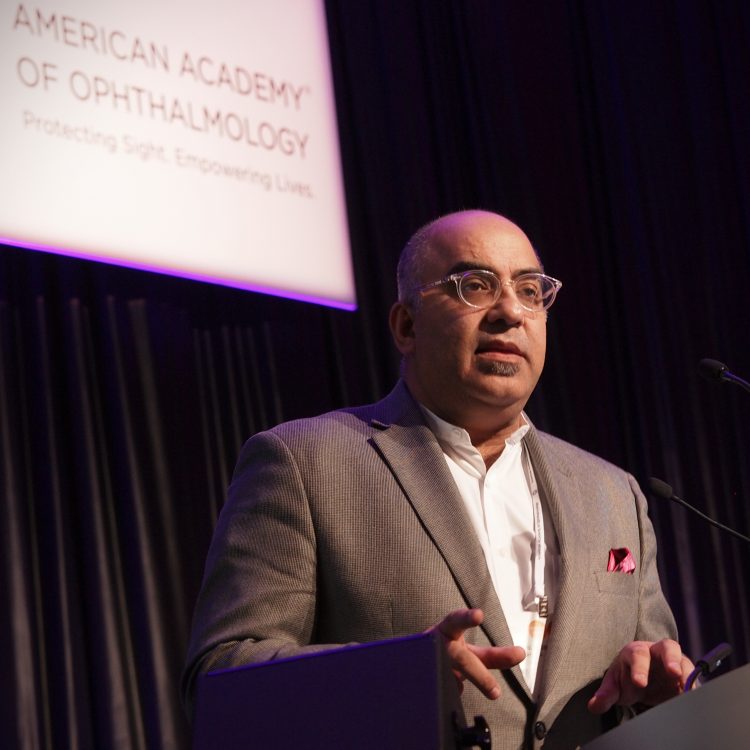Elasticity and healing in paediatric cataract surgery
Elasticity and healing of a child’s eye are completely different

Ken Nischal
Published: Monday, November 4, 2019
 Dr Ken Nischal
Elasticity and healing of a child’s eye are completely different. If you also look at neuroplasticity, it completely changes the approach. Paediatric cataracts are visually significant either because they are total or because the location causes light diffraction. Dilating the pupil around a central cataract can buy time but can affect macular function. Therefore, a ≥3mm opacity in the central visual axis should be dealt with sooner rather than later. Surgery should, however, be safe. In infants, the risk of glaucoma is always present and studies show that operating after four weeks of age is better than operating before. Limbal or clear corneal incisions are preferred as scleral tunnels violate conjunctiva and affect success of any future filtration surgery. Under four years of age, posterior rhexis with anterior vitrectomy is important. I personally also do posterior capsulorhexis without anterior vitrectomy in children between four and 16 years of age, because doing YAG capsulotomy is never easy in children. I prefer the two-incision push-pull rhexis technique, described by me for both anterior and posterior capsules.
Age of the child determines postoperative targeted refraction. In children below two years, rapid growth of the eye is expected. Below one year, an immediate postoperative +4D may result in -6D at two-to-three years age. So, under one year, I usually aim for +8D and at six months, for +10D. While that may appear problematic, remember that in the first 18 months of life, there is a 3.5mm growth of the eye, translating to approximately 10.5D shift, and this definitely needs to be taken into account. There is an argument to keep the child slightly myopic, but that is more relevant when the child is around three-to-six years of age.
For children referred from other countries, a minimum six weeks’ follow-up allows a final refraction at four weeks, any complications to be dealt with and a proper surgical follow-up plan to be formulated with the local doctor.
Dr Ken Nischal
Elasticity and healing of a child’s eye are completely different. If you also look at neuroplasticity, it completely changes the approach. Paediatric cataracts are visually significant either because they are total or because the location causes light diffraction. Dilating the pupil around a central cataract can buy time but can affect macular function. Therefore, a ≥3mm opacity in the central visual axis should be dealt with sooner rather than later. Surgery should, however, be safe. In infants, the risk of glaucoma is always present and studies show that operating after four weeks of age is better than operating before. Limbal or clear corneal incisions are preferred as scleral tunnels violate conjunctiva and affect success of any future filtration surgery. Under four years of age, posterior rhexis with anterior vitrectomy is important. I personally also do posterior capsulorhexis without anterior vitrectomy in children between four and 16 years of age, because doing YAG capsulotomy is never easy in children. I prefer the two-incision push-pull rhexis technique, described by me for both anterior and posterior capsules.
Age of the child determines postoperative targeted refraction. In children below two years, rapid growth of the eye is expected. Below one year, an immediate postoperative +4D may result in -6D at two-to-three years age. So, under one year, I usually aim for +8D and at six months, for +10D. While that may appear problematic, remember that in the first 18 months of life, there is a 3.5mm growth of the eye, translating to approximately 10.5D shift, and this definitely needs to be taken into account. There is an argument to keep the child slightly myopic, but that is more relevant when the child is around three-to-six years of age.
For children referred from other countries, a minimum six weeks’ follow-up allows a final refraction at four weeks, any complications to be dealt with and a proper surgical follow-up plan to be formulated with the local doctor.